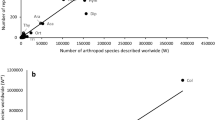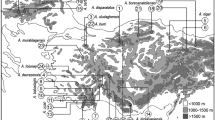Abstract
Distinguishing between species that are recent natural colonists, recent anthropogenic introductions, or previously unknown, but long-term resident native species, is a challenge for those who manage the conservation of the Antarctic region. Here, we report the discovery of two new arthropod species on sub-Antarctic Marion Island—Nabis capsiformis Germar (Heteroptera: Nabidae) and Tetragnatha sp. (Araneomorphae: Tetragnathidae). On the basis of their habitat use, dispersal abilities, historic biodiversity survey records, and limited information on genetic diversity, we conclude that the colonization events were natural.




Similar content being viewed by others
References
Anonymous (1996) Prince Edward Islands Management Plan. Department of Environmental Affairs, Pretoria, South Africa
Bell JR, Bohan DA, Shaw EM, Weyman GS (2005) Ballooning dispersal using silk: world fauna, phylogenies, genetics and models. Bull Entomol Res 95:69–114
Bester MN, Bloomer JP, van Aarde RJ, Erasmus BH, van Rensburg PJJ, Skinner JD, Howell PG, Naude TW (2002) A review of the successful eradication of feral cats from sub-Antarctic Marion Island, Southern Indian Ocean. S Afr J Wildl Res 32:65–73
Burger AE, Williams AJ, Sinclair JC (1980) Vagrants and the paucity of land bird species at the Prince Edward islands. J Biogeogr 7:305–310
Chown SL, Avenant N (1992) Status of Plutella xylostella at Marion Island six years after its colonization. S Afr J Antarct Res 22:37–40
Chown SL, Froneman PW (eds) (2008) The Prince Edward Islands. Land–sea interactions in a changing ecosystem. Sun Press, Stellenbosch
Chown SL, McGeoch MA, Marshall DJ (2002) Diversity and conservation of invertebrates on the sub-Antarctic Prince Edward Islands. Afr Entomol 10:67–82
Chown SL, Lee JE, Shaw JD (2008a) Conservation of Southern Ocean Islands: invertebrates as exemplars. J Insect Conserv 12:277–291
Chown SL, Sinclair BJ, Jansen van Vuuren B (2008b) DNA barcoding and the documentation of alien species establishment on sub-Antarctic Marion Island. Polar Biol 31:651–655
Chown SL, Huiskes AHL, Gremmen NJM, Lee JE, Terauds A, Crosbie K, Frenot Y, Hughes KA, Imura S, Kiefer K, Lebouvier M, Raymond B, Tsujimoto M, Ware C, Van de Vijver B, Bergstrom DM (2012) Continent-wide risk assessment for the establishment of nonindigenous species in Antarctica. Proc Natl Acad Sci USA 109:4938–4943
Convey P, Key RS, Key RJD (2010) The establishment of a new ecological guild of pollinating insects on sub-Antarctic South Georgia. Antarct Sci 22:508–512
Crafford JE, Scholtz CH, Chown SL (1986) The insects of sub-Antarctic Marion and Prince Edward Islands; with a bibliography of entomology of the Kerguelen Biogeographical Province. S Afr J Antarct Res 16:42–84
Cuba-Díaz M, Troncoso JM, Cordero C, Finot VL, Rondanelli-Reyes M (2013) Juncus bufonis, a new non-native vascular plant in King George Island, South Shetland Islands. Antarct Sci 25:385–386
de Villiers MS, Cooper J, Carmichael N, Glass JP, Liddle GM, McIvor E, Micol T, Roberts A (2006) Conservation management at Southern Ocean Islands: towards the development of best-practice guidelines. Polarforschung 75:113–131
Dippenaar-Schoeman AS, Jocqué R (1997) African spiders, an identification manual. Biosystematics Division, ARC-Plant Protection Research Institute, Pretoria. Handbook 9
Folmer O, Black M, Hoeh W, Lutz R, Vrijenhoek R (1994) DNA primers for amplification of mitochondrial cytochrome c oxidase subunit I from diverse metazoan invertebrates. Mol Mar Biol Biotech 3:294–299
Frenot Y, Chown SL, Whinam J, Selkirk PM, Convey P, Skotnicki M, Bergstrom DM (2005) Biological invasions in the Antarctic: extent, impacts and implications. Biol Rev 80:45–72
Gaston KJ, Jones AG, Hänel C, Chown SL (2003) Rates of species introduction to a remote oceanic island. Proc R Soc B 270:1091–1098
Gillespie RG (2002) Biogeography of spiders on remote oceanic islands of the Pacific: archipelagoes as stepping stones? J Biogeogr 29:655–662
Gremmen NJM, Smith VR (1999) New records of alien vascular plants from Marion and Prince Edward Islands, sub-Antarctic. Polar Biol 21:401–409
Gremmen NJM, Barendse J, Orr I (2001) Invasion and eradication of Sagina procumbens L. (procumbent pearlwort) on Gough Island. Aliens 14:19–20
Gropali R, Priano M, Pesarini C (1996) Notes on spiders (Arachnida, Araneae) of tree-shrub habitats found in Urbino surroundings (Central Apennines, Italy). Redia 79:83–90
Hughes KA, Convey P (2012) Determining the native/non-native status of newly discovered terrestrial and freshwater species in Antarctica—current knowledge, methodology and management action. J Environ Manag 93:52–66
Hughes KA, Lee JE, Tsujimoto M, Imura S, Bergstrom DM, Ware C, Lebouvier M, Huiskes A, Gremmen NJM, Frenot Y, Bridge PD, Chown SL (2011) Food for thought: risks of non-native species transfer to the Antarctic region with fresh produce. Biol Conserv 144:1682–1689
Jumbam K, Terblanche J, Deere JA, Somers M, Chown SL (2008) Critical thermal limits and their responses to acclimation in two sub-Antarctic spiders: Myro kerguelenensis and Prinerigone vagans. Polar Biol 31:215–220
Kerzhner IM (1977) Zufallige einfliige als ursache der funde von Nabis capsiformis (Heteroptera, Nabidae) in Mitteleuropa. VII. International symposium uber Entomofaunistik in Mitteleuropa. Zusammenfassungen. Nauka Publications, Leningrad
Kerzhner IM (1983) Airborne Nabis capsiformis (Heteroptera: Nabidae) from the Atlantic, Indican and Pacific Oceans. Int J Entomol 25:273–275
Khoza TT, Dippenaar SM, Dippenaar-Schoeman AS (2005) The biodiversity and species composition of the spider community of Marion Island, a recent survey (Arachnida: Araneae). Koedoe 48:103–107
Le Roux PC, Ramaswiela T, Kalwij JM, Shaw JD, Ryan PG, Treasure AM, McClelland GTW, McGeoch MA, Chown SL (2013) Human activities, propagule pressure, and alien plants in the sub-Antarctic: tests of generalities and evidence in support of management. Biol Conserv 161:18–27
Lee JE, Slabber S, van Vuuren BJ, van Noort S, Chown SL (2007) Colonisation of sub-Antarctic Marion Island by a non-indigenous aphid parasitoid Aphidius matricariae (Hymenoptera, Braconidae). Polar Biol 30:1195–1201
Lee JE, Janion C, Marais E, van Vuuren BJ, Chown SL (2009) Physiological tolerances account for range limits and abundance structure in an invasive slug. Proc R Soc B 276:1459–1468
Lee JE, Somers MJ, Chown SL (2012) Density, body size and sex ratio of an indigenous spider along an altitudinal gradient in the sub-Antarctic. Antarct Sci 24:15–22
Lityńska-Zając M, Chwedorzewska K, Olech M, Korczak-Abshire M, Augustyniuk-Kram A (2012) Diaspores and phyto-remains accidentally transported to the Antarctic Station during three expeditions. Polar Biol 21:3411–3421
McGaughran A, Convey P, Stevens MI, Chown SL (2010) Metabolic rate, genetic and microclimate variation among springtail populations from sub-Antarctic Marion Island. Polar Biol 33:909–918
Myburgh M, Chown SL, van Vuuren BJ (2007) Population structure, propagule pressure, and conservation biogeography in the sub-Antarctic: lessons from indigenous and invasive springtails. Divers Distrib 13:143–154
Pyšek P, Richardson DM (2007) Traits associated with invasiveness in alien plants. In: Nentwig W (ed) Ecological studies, vol 139. Springer, Berlin, pp 97–125
Saw J, Endersby NM, McKechnie SW (2006) Low mtDNA diversity among widespread Australian diamondback moth Plutella xylostella (L.) suggests isolation and a founder effect. Insect Sci 13:365–373
Scholtz CH, Holm E (1985) Insects of Southern Africa. Butterworths, Durban
Shepherd LD, de Lange PJ, Perrie LR (2009) Multiple colonizations of a remote oceanic archipelago by one species: how common is long-distance dispersal? J Biogeogr 36:1972–1977
Slabber S, Chown SL (2002) The first record of a terrestrial crustacean, Porcellio scaber (Isopoda, Porcellionidae), from sub-Antarctic Marion Island. Polar Biol 25:855–858
Vincent LS (1980) Field observations on the biology of Tetragnatha extensa Emerton, in a riparian habitat (Araneae, Tetragnathidae). Pan-Pac Entomol 56:316–318
Volonterio O, de León RP, Convey P, Krzemińska E (2013) First record of Trichoceridae (Diptera) in the maritime Antarctic. Polar Biol 36:1125–1131
Whittaker R (1998) Island biogeography. Ecology, evolution, and conservation. Oxford University Press, Oxford
Wilson JRU, Richardson DM, Rouget M, Procheş S, Amis MA, Henderson L, Thuiller W (2007) Residence time and potential range: crucial considerations in modelling plant invasions. Divers Distrib 13:11–22
Acknowledgments
A. Dippenaar-Schoeman and R. Stals, and D. H. Jacobs provided taxonomic assistance with the spider and bugs, respectively. J. K. Davis and A. Tshautshau provided assistance in the field. A. Treasure provided assistance with the figures and comments on the MS. Three anonymous reviewers provided helpful comments on the MS. This work was supported by South African National Research Foundation Grant SNA2011110700005.
Author information
Authors and Affiliations
Corresponding author
Rights and permissions
About this article
Cite this article
Lee, J.E., Terauds, A. & Chown, S.L. Natural dispersal to sub-Antarctic Marion Island of two arthropod species. Polar Biol 37, 781–787 (2014). https://doi.org/10.1007/s00300-014-1479-9
Received:
Revised:
Accepted:
Published:
Issue Date:
DOI: https://doi.org/10.1007/s00300-014-1479-9




